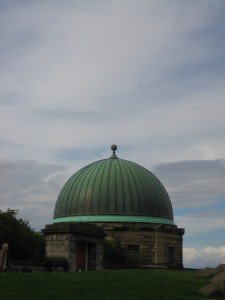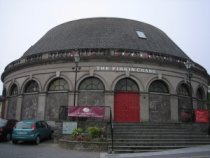Wed 28 Sep 2011
Why Domes?
Posted by Nicole Canham under Domes
No Comments
What symbol would we use to get your attention in a public space? A big blue thumb (like this) sign? A giant red arrow?
Just as a special gift might reflect how we feel about another person, we find clues as to how different people feel about our society, and what our life should contain in our surroundings. There are stand-out architectural examples that dominate our skyline. Think of the Sydney Opera House with those amazing sail-like shells –people all over the world who see a picture of that building associate it with Australia and with Sydney. It’s a calling card for us all. There are things we walk past everyday loudly vying for our attention, like enormous illuminated advertisement billboards, and then there are special occasion instances like the light projections we find every year as part of the Vivid Festival. But what did we do in earlier times when engineering and design were more modest, when we didn’t have electricity, when the idea of marketing and brands and getting people’s attention was in its infancy? Where might we find the clues in our early buildings? Well, in Sydney, it all started with a dome.
The interesting thing about the settlement of Australia by Great Britain in the late 1700s is that it was designated a penal colony and rather than building a gaol and putting people in it, the whole country became the prison settlement. So you might imagine that it was rather a momentous occasion when, for the first time, it was decided that everyone who lived outside of the Hyde Park Barracks was a free man, and those who were incarcerated were the people who were serving time for their crimes. For Governor Macquarie, this was a significant shift in our thinking about Australia and a move towards the ‘civilising’ of our society. The addition of domes to the guardhouses of the Hyde Park Barracks was an important part of symbolising this shift in thinking. A ‘civilised’ society incorporated fine architecture which included decorative features like domes. Today, people walk past the Hyde Park Barracks without giving a second thought to the importance of that building in our history or the meaning of those fairly modest objects being reconstructed underneath a shield of scaffolding and hessian. And yet that symbol, and the act of thinking that we were capable of building a society with all the benefits and finery we could possibly imagine, were the beginnings of the modern Australia that we enjoy today.
It is human nature to attach meaning to different symbols and objects, to define spaces for specific purposes – we do it a lot with smaller objects that represent aspects of our own lives. A favourite coffee cup, a pair of earrings given to us for a birthday or anniversary, a dirty, beat-up toy that a child refuses to part with…all those objects have meaning for us beyond the value of the materials themselves. It’s what we see there and how it makes us feel about ourselves that gives the object its importance to us. How often do we stop to use this way of seeing things – some might call it seeing with your heart – in our shared public spaces? To admire the outline of a building, the placement of a park or to notice something else that pleases us and to realise in that moment that other people have been responsible for that; that someone else has left a message of something interesting or beautiful for us to see in our comings and goings in daily life. Of course we are all very quick to complain when we find a sculpture or construction site that isn’t to our liking. How good are we at practising the discipline of appreciating what others preserve for the benefit of us all?
We’d love to hear how you would design your own ultimate Sydney building, or reclaim a famous Sydney place at our Skyline School Holiday workshops, or through our Domes Shingle competition where you can add you own design to our shingle template, send it in and have a chance at winning a great prize!

